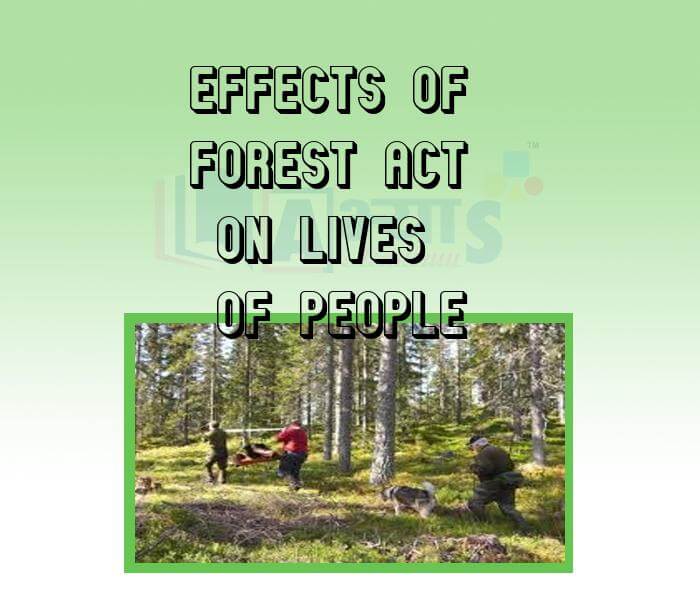Effects of Forest Act on Lives of People

Effects of Forest Act on Lives of People
EFFECTS OF FOREST ACT ON LIVES OF PEOPLE:
Effect of Forest Rules on Cultivation: The major impact of forest laws was the ban on shifting cultivation or swidden agriculture.
In shifting cultivation, parts of the forest are cut and burnt in rotation. Seeds are sown in ashes after the first monsoon rain and the crops are harvested by October-November. Such plots are cultivated for a couple of years and then left fallow for 12 to 18 years for the forest to grow back. A mixture of crops is grown on these plots.
DEFINITION OF SHIFTING CULTIVATION: An area is cleared for cultivation for a period of time after that it left uncultivated so that it could gain fertility.
Note The shifting cultivation has many local names, like lading in South East Asia, milpa in Central America, chitemene or tavy in Africa, chena in Sri Lanka. In India also it has many local names like, dhya, penda, bewar, nevad, jhum, podu, khandad, Kumri, etc.
Banning of Shifting Cultivation:
European foresters regarded the practice of shifting cultivation was harmful for the forests. When a forest was burnt there was a danger of spreading flames and burning valuable timbers.
Shifting cultivation made it more difficult for the government to calculate taxes. So, the British Government decided to ban shifting cultivation. As a result, some communities were forcibly displaced from their homes. Some of them had to change their occupations, while some revolted against the law.
Taungya Cultivation: - It was a system in which local farmers were allowed to cultivate temporarily within a plantation. When the cultivators were sowing paddy, the men made holes in the soil using long bamboo poles with iron tips. The women sowed paddy in each hole.
PROHIBITION ON HUNTING AFTER FOREST ACT:
NEW TRADES, NEW EMPLOYMENTS AND NEW SERVICES:
Rebellion in the Forest: - In many parts of India and across the world, forest communities rebelled against the changes that were being imposed on them. In India, Siddhu and Kanu of Santhal Paraganas, Birsa Munda of Chhotanagpur, Alluri Sitarama Raju of Andhra Pradesh who revolted against the new forest policy are still remembered today in many songs and stories.
Students / Parents Reviews [10]
Abhyas Methodology is very good. It is based on according to student and each child manages accordingly to its properly. Methodology has improved the abilities of students to shine them in future.

Manish Kumar
10thMy experience with Abhyas academy is very good. I did not think that my every subject coming here will be so strong. The main thing is that the online tests had made me learn here more things.

Hiya Gupta
8thIt was good as the experience because as we had come here we had been improved in a such envirnment created here.Extra is taught which is beneficial for future.

Eshan Arora
8thMy experience with Abhyas is very good. I have learnt many things here like vedic maths and reasoning also. Teachers here first take our doubts and then there are assignments to verify our weak points.

Shivam Rana
7thIt has a great methodology. Students here can get analysis to their test quickly.We can learn easily through PPTs and the testing methods are good. We know that where we have to practice

Barkha Arora
10thOne of the best institutes to develope a child interest in studies.Provides SST and English knowledge also unlike other institutes. Teachers are co operative and friendly online tests andPPT develope practical knowledge also.

Aman Kumar Shrivastava
10thBeing a parent, I saw my daughter improvement in her studies by seeing a good result in all day to day compititive exam TMO, NSO, IEO etc and as well as studies. I have got a fruitful result from my daughter.

Prisha Gupta
8thAbhyas is a complete education Institute. Here extreme care is taken by teacher with the help of regular exam. Extra classes also conducted by the institute, if the student is weak.

Om Umang
10thAbout Abhyas metholodology the teachers are very nice and hardworking toward students.The Centre Head Mrs Anu Sethi is also a brilliant teacher.Abhyas has taught me how to overcome problems and has always taken my doubts and suppoeted me.

Shreya Shrivastava
8thMy experience was very good with Abhyas academy. I am studying here from 6th class and I am satisfied by its results in my life. I improved a lot here ahead of school syllabus.









